Enable S5 in ACRN¶
Introduction¶
S5 is one of the ACPI sleep states that refers to the system being shut down (although some power may still be supplied to certain devices). In this document, S5 means the function to shut down the User VMs, Service VM, the hypervisor, and the hardware. In most cases, directly powering off a computer system is not advisable because it can damage some components. It can cause corruption and put the system in an unknown or unstable state. On ACRN, the User VM must be shut down before powering off the Service VM. Especially for some use cases, where User VMs could be used in industrial control or other high safety requirement environment, a graceful system shutdown such as the ACRN S5 function is required.
S5 Architecture¶
ACRN provides a mechanism to trigger the S5 state transition throughout the system. It uses a vUART channel to communicate between the Service and User VMs. The diagram below shows the overall architecture:
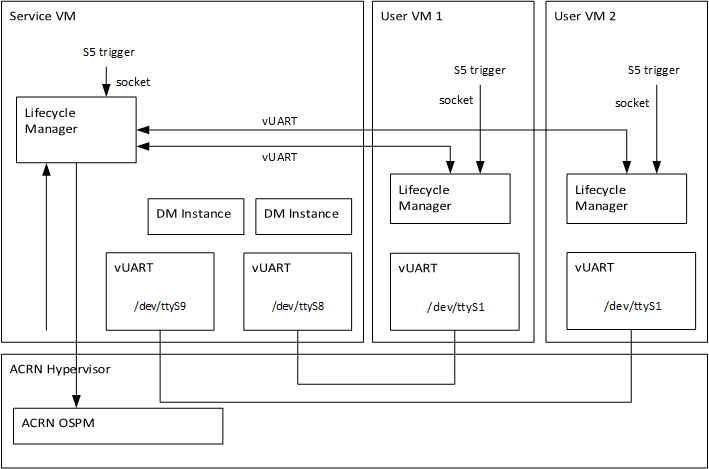
Figure 24 S5 overall architecture¶
vUART channel:
The User VM’s serial port device (
/dev/ttySn) is emulated in the Hypervisor. The channel from the Service VM to the User VM:![digraph G {
node [shape=plaintext fontsize=12];
rankdir=LR;
bgcolor="transparent";
"Service VM:/dev/ttyS8" -> "ACRN hypervisor" -> "User VM:/dev/ttyS1" [arrowsize=.5];
}](../_images/graphviz-05e883f8b8e2ee49ea6e8c5059b34078354b1ece.png)
Lifecycle Manager Overview¶
As part of the S5 reference design, a Lifecycle Manager daemon (life_mngr in Linux,
life_mngr_win.exe in Windows) runs in the Service VM and User VMs to implement S5.
Operator or user can use s5_trigger_linux.py or s5_trigger_win.py script to initialize
a system S5 in the Service VM or User VMs. The Lifecycle Manager in the Service VM and
User VMs wait for system S5 request on the local socket port.
Initiate a System S5 from within a User VM (e.g., HMI)¶
As shown in the Figure 24, a request to Service VM initiates the shutdown flow.
This could come from a User VM, most likely the HMI (running Windows or Linux).
When a human operator initiates the flow through running s5_trigger_linux.py or s5_trigger_win.py,
the Lifecycle Manager (life_mngr) running in that User VM sends the system S5 request via
the vUART to the Lifecycle Manager in the Service VM which in turn acknowledges the request.
The Lifecycle Manager in Service VM sends poweroff_cmd request to User VMs, when the Lifecycle Manager
in User VMs receives poweroff_cmd request, it sends ack_poweroff to the Service VM;
then it shuts down the User VMs. If the User VMs is not ready to shut down, it can ignore the
poweroff_cmd request.
Note
The User VM need to be authorized to be able to request a system S5, this is achieved
by configuring ALLOW_TRIGGER_S5 in the Lifecycle Manager service configuration /etc/life_mngr.conf
in the Service VM. There is only one User VM in the system can be configured to request a shutdown.
If this configuration is wrong, the system S5 request from User VM is rejected by
Lifecycle Manager of Service VM, the following error message is recorded in Lifecycle Manager
log /var/log/life_mngr.log of Service VM:
The user VM is not allowed to trigger system shutdown
Initiate a System S5 within the Service VM¶
On the Service VM side, it uses the s5_trigger_linux.py to trigger the system S5 flow. Then,
the Lifecycle Manager in service VM sends a poweroff_cmd request to the lifecycle manager in each
User VM through the vUART channel. If the User VM receives this request, it will send an ack_poweroff
to the lifecycle manager in Service VM. It is the Service VM’s responsibility to check whether the
User VMs shut down successfully or not, and to decide when to shut the Service VM itself down.
Note
Service VM is always allowed to trigger system S5 by default.
Enable S5¶
Configure communication vUART for Service VM and User VMs:
Add these lines in the hypervisor scenario XML file manually:
Example:
/* VM0 */ <vm_type>SERVICE_VM</vm_type> ... <legacy_vuart id="1"> <type>VUART_LEGACY_PIO</type> <base>CONFIG_COM_BASE</base> <irq>0</irq> <target_vm_id>1</target_vm_id> <target_uart_id>1</target_uart_id> </legacy_vuart> <legacy_vuart id="2"> <type>VUART_LEGACY_PIO</type> <base>CONFIG_COM_BASE</base> <irq>0</irq> <target_vm_id>2</target_vm_id> <target_uart_id>2</target_uart_id> </legacy_vuart> ... /* VM1 */ <vm_type>POST_STD_VM</vm_type> ... <legacy_vuart id="1"> <type>VUART_LEGACY_PIO</type> <base>COM2_BASE</base> <irq>COM2_IRQ</irq> <target_vm_id>0</target_vm_id> <target_uart_id>1</target_uart_id> </legacy_vuart> ... /* VM2 */ <vm_type>POST_STD_VM</vm_type> ... <legacy_vuart id="1"> <type>VUART_LEGACY_PIO</type> <base>INVALID_COM_BASE</base> <irq>COM2_IRQ</irq> <target_vm_id>0</target_vm_id> <target_uart_id>2</target_uart_id> </legacy_vuart> <legacy_vuart id="2"> <type>VUART_LEGACY_PIO</type> <base>COM2_BASE</base> <irq>COM2_IRQ</irq> <target_vm_id>0</target_vm_id> <target_uart_id>2</target_uart_id> </legacy_vuart> ... /* VM3 */ ...
Note
These vUART is emulated in the hypervisor; expose the node as
/dev/ttySn. For the User VM with the minimal VM ID, the communication vUART id should be 1. For other User VMs, the vUART (id is 1) shoulbe be configured as invalid, the communication vUART id should be 2 or others.
Build the Lifecycle Manager daemon,
life_mngr:cd acrn-hypervisor make life_mngr
For Service VM, LaaG VM and RT-Linux VM, run the Lifecycle Manager daemon:
Copy
life_mngr.conf,s5_trigger_linux.py,user_vm_shutdown.py,life_mngr, andlife_mngr.serviceinto the Service VM and User VMs.scp build/misc/services/s5_trigger_linux.py root@<target board address>:~/ scp build/misc/services/life_mngr root@<target board address>:/usr/bin/ scp build/misc/services/life_mngr.conf root@<target board address>:/etc/life_mngr/ scp build/misc/services/life_mngr.service root@<target board address>:/lib/systemd/system/ scp misc/services/life_mngr/user_vm_shutdown.py root@<target board address>:~/
Note
user_vm_shutdown.pyis only needed to be copied into Service VM.Edit options in
/etc/life_mngr/life_mngr.confin the Service VM.VM_TYPE=service_vm VM_NAME=Service_VM DEV_NAME=tty:/dev/ttyS8,/dev/ttyS9,/dev/ttyS10,/dev/ttyS11,/dev/ttyS12,/dev/ttyS13,/dev/ttyS14 ALLOW_TRIGGER_S5=/dev/ttySn
Note
The mapping between User VM ID and communication serial device name (
/dev/ttySn) in the/etc/serial.conf. If/dev/ttySnis configured in theALLOW_TRIGGER_S5, this means system shutdown is allowed to be triggered in the corresponding User VM.Edit options in
/etc/life_mngr/life_mngr.confin the User VM.VM_TYPE=user_vm VM_NAME=<User VM name> DEV_NAME=tty:/dev/ttyS1 #ALLOW_TRIGGER_S5=/dev/ttySn
Note
The User VM name in this configuration file should be consistent with the VM name in the launch script for the Post-launched User VM or the VM name which is specified in the hypervisor scenario XML for the Pre-launched User VM.
Use the following commands to enable
life_mngr.serviceand restart the Service VM and User VMs.sudo chmod +x /usr/bin/life_mngr sudo systemctl enable life_mngr.service sudo reboot
Note
For the Pre-launched User VM, need restart Lifecycle Manager service manually after Lifecycle Manager in Service VM starts.
For the WaaG VM, run the lifecycle manager daemon:
Build the
life_mngr_win.exeapplication ands5_trigger_win.py:cd acrn-hypervisor make life_mngr
Note
If there is no
x86_64-w64-mingw32-gcccompiler, you can runsudo apt install gcc-mingw-w64-x86-64on Ubuntu to install it.Copy
s5_trigger_win.pyinto the WaaG VM.Set up a Windows environment:
Download the Python3 from https://www.python.org/downloads/release/python-3810/, install “Python 3.8.10” in WaaG.
If Lifecycle Manager for WaaG will be built in Windows, download the Visual Studio 2019 tool from https://visualstudio.microsoft.com/downloads/, and choose the two options in the below screenshots to install “Microsoft Visual C++ Redistributable for Visual Studio 2015, 2017 and 2019 (x86 or X64)” in WaaG:
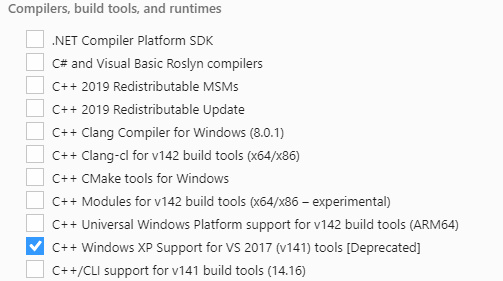
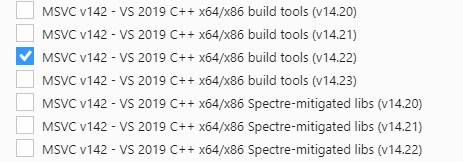
Note
If Lifecycle Manager for WaaG is built in Linux, Visual Studio 2019 tool is not needed for WaaG.
In WaaG, use the Windows + R shortcut key, input
shell:startup, click OK and then copy thelife_mngr_win.exeapplication into this directory.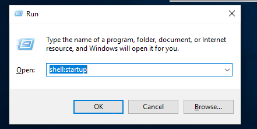

Restart the WaaG VM. The COM2 window will automatically open after reboot.
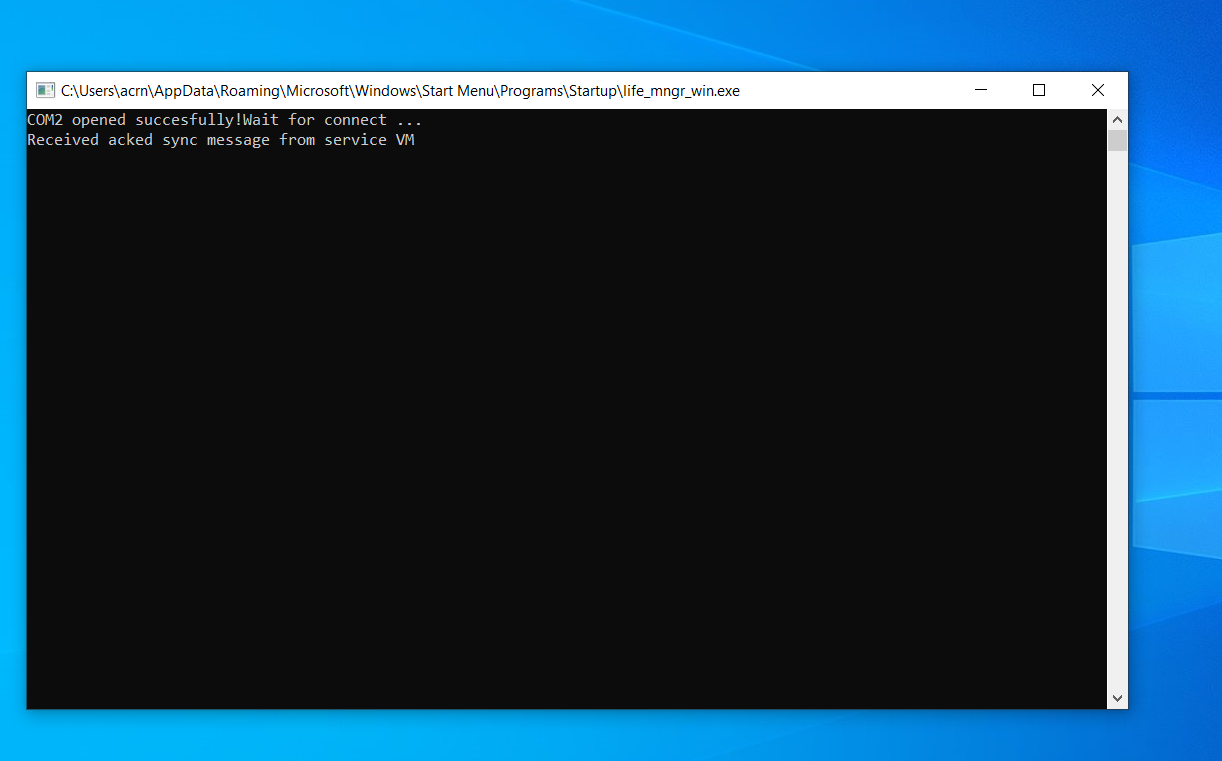
If
s5_trigger_linux.pyis run in the Service VM, the Service VM will shut down (transitioning to the S5 state), it sends poweroff request to shut down the User VMs.Note
S5 state is not automatically triggered by a Service VM shutdown; this needs to run
s5_trigger_linux.pyin the Service VM.
How to Test¶
As described in Enable vUART Configurations, two vUARTs are defined for User VM in pre-defined ACRN scenarios: vUART0/ttyS0 for the console and vUART1/ttyS1 for S5-related communication (as shown in S5 overall architecture).
For Yocto Project (Poky) or Ubuntu rootfs, the
serial-gettyservice forttyS1conflicts with the S5-related communication use ofvUART1. We can eliminate the conflict by preventing that service from being started either automatically or manually, by masking the service using this commandsystemctl mask serial-getty@ttyS1.service
Refer to the Enable S5 section to set up the S5 environment for the User VMs.
Note
Use the
systemctl status life_mngr.servicecommand to ensure the service is working on the LaaG or RT-Linux:* life_mngr.service - ACRN lifemngr daemon Loaded: loaded (/lib/systemd/system/life_mngr.service; enabled; vendor preset: enabled) Active: active (running) since Thu 2021-11-11 12:43:53 CST; 36s ago Main PID: 197397 (life_mngr)
Note
For WaaG, we need to close
windbgby using thebcdedit /set debug offcommand IF you executed thebcdedit /set debug onwhen you set up the WaaG, because it occupies theCOM2.Use the
user_vm_shutdown.pyin the Service VM to shut down the User VMs:sudo python3 ~/user_vm_shutdown.py <User VM name>
Note
The User VM name is configured in the
life_mngr.confof User VM. For the WaaG VM, the User VM name is “windows”.Use the
acrnctl listcommand to check the User VM status.sudo acrnctl list <User VM name> stopped
System Shutdown¶
Using a coordinating script, s5_trigger_linux.py or s5_trigger_win.py,
in conjunction with the Lifecycle Manager in each VM, graceful system shutdown
can be performed.
In the hybrid_rt scenario, operator can use the script to send a system shutdown
request via /var/lib/life_mngr/monitor.sock to User VM which is configured to be allowed to
trigger system S5, this system shutdown request is forwarded to the Service VM, the
Service VM sends poweroff request to each User VMs (Pre-launched VM or Post-launched VM)
through vUART. The Lifecycle Manager in the User VM receives the poweroff request, sends an
ack message, and proceeds to shut itself down accordingly.
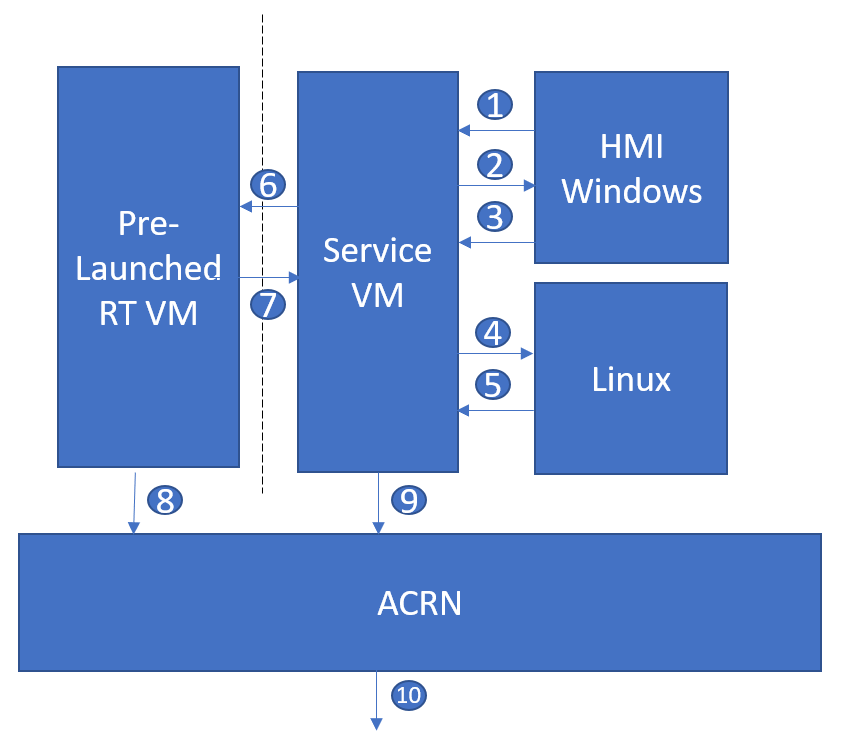
Figure 25 Graceful system shutdown flow¶
The HMI in the Windows VM uses
s5_trigger_win.pyto send system shutdown request to the Lifecycle Manager, Lifecycle Manager forwards this request to Lifecycle Manager in the Service VM.The Lifecycle Manager in the Service VM responds with an ack message and sends
poweroff_cmdrequest to Windows VM.After receiving the
poweroff_cmdrequest, the Lifecycle Manager in the HMI Windows VM responds with an ack message, then shuts down VM.The Lifecycle Manager in the Service VM sends
poweroff_cmdrequest to Linux User VM.After receiving the
poweroff_cmdrequest, the Lifecycle Manager in the Linux User VM responds with an ack message, then shuts down VM.The Lifecycle Manager in the Service VM sends
poweroff_cmdrequest to Pre-launched RTVM.After receiving the
poweroff_cmdrequest, the Lifecycle Manager in the Pre-launched RTVM responds with an ack message.The Lifecycle Manager in the Pre-launched RTVM shuts down the VM using ACPI PM registers.
After receiving the ack message from all user VMs, the Lifecycle Manager in the Service VM shuts down VM.
The hypervisor shuts down the system after all VMs have shut down.
Note
If one or more virtual functions (VFs) of a SR-IOV device, e.g. GPU on Alder Lake platform, are assigned to User VMs, extra steps should be taken by user to disable all VFs before Service VM shuts down. Otherwise, Service VM may fail to shut down due to some enabled VFs.